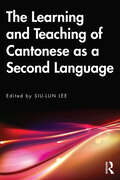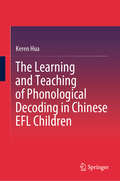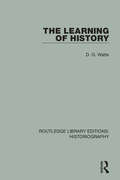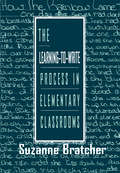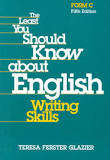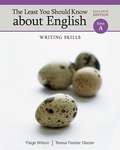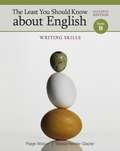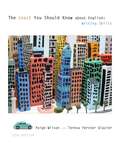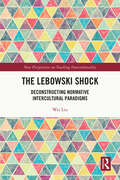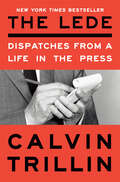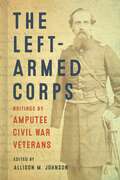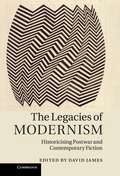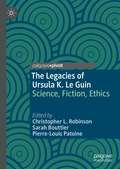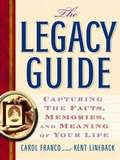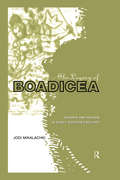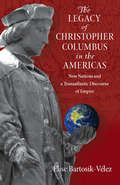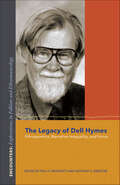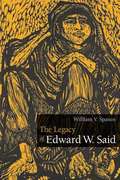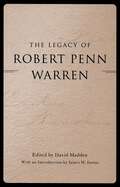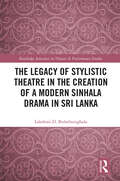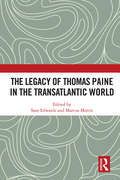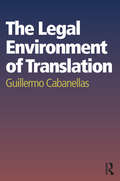- Table View
- List View
The Learning and Teaching of Cantonese as a Second Language
by Siu-Lun LeeThe Learning and Teaching of Cantonese as a Second Language brings together contributions on such issues as Cantonese textbooks, linguistic description, literacy and tone acquisition, supplemented by case studies from the Netherlands and Japan. The learning and teaching of Cantonese as a second language is a subject of considerable interest in the international academic community, and the first international symposium on teaching Cantonese as a second language, held at the Chinese University of Hong Kong in October 2019, brought together leading researchers in this field. This conference provided the inspiration for the current volume, The Learning and Teaching of Cantonese as a Second Language. In the Hong Kong context, historically, the term ‘Cantonese’ refers to the language varieties of immigrants who came to the territory from various areas in Guangdong province, including Macau, Panyu, Taishan, Xinhui and Zhongshan. From the late nineteenth century onwards, their speech coalesced into the contemporary variety of Cantonese used in Hong Kong today. The term ‘Cantonese’ is also used to refer to the entire Yue subgroup of Chinese, which includes varieties of Cantonese spoken in southern China, Hong Kong, Macau, Malaysia, Singapore and among overseas Chinese in Australia, Europe and North America. In all, it is estimated that there are about 70 million Cantonese speakers in the world. This volume is of direct relevance to educators, language teachers, linguists and all those concerned with the learning of Cantonese as a second language.
The Learning and Teaching of Phonological Decoding in Chinese EFL Children
by Keren HuaThis book presents the learning and teaching of phonological decoding in Chinese EFL primary classrooms. The phonological decoding ability of the children is described, interpreted, and evaluated, the teaching materials are analyzed and the classroom instruction observed, and the links between these various facets are explored using both quantitative and qualitative techniques (textbook analysis, classroom observations, interviews with teachers and a textbook writer, reading test and nonword reading test). This book provides insights into Chinese children’s phonological decoding profile, including performance in decoding different types of orthographic units, the strategies children at different levels of reading ability use to sound out vowel graphemes, and their decoding ability in relation to reading ability. The investigation of the teaching practices reveals how the decoding instruction is designed, developed, and delivered to the children and thereby informs the interplay between the classroom instruction and children’s development of phonological decoding skills.
The Learning of History (Routledge Library Editions: Historiography)
by D. G. WattsOriginally published in 1972, this book is a systematic analysis of the objectives and methods of history teaching. The book considers the criticisms of the 1960s and 70s of history as a subject and the pressures for its replacement in the school curriculum. It examines the complex psychological background of learning history and suggests that historical understanding makes an important contribution to cognitive growth. It also stresses the important part played by historical material in the emotional and imaginative life of the child. Concluding with a discussion of practical classroom methods, the author proposes objectives and characteristic concepts of the subject which may be embodied in all levels of teaching.
The Learning-to-write Process in Elementary Classrooms
by Suzanne BratcherThis text models for teachers how to help children learn and write by establishing comfort with writing, building confidence, and developing competence. Several themes run through the learning-to-write-process presented in this text:* Writing is communication;* Writing is a powerful tool for learning;* How children feel about their writing and themselves as writers affects how they learn to write;* Teachers are coworkers with students; children from many backgrounds can learn to write together. The text sythesizes what we know about how children learn, how we write, and what we write into a process of teaching children to write. It is intended to serve as a starting place for developing theories of how to best teach writing.
The Least You Should Know About English: Basic Writing Skills (Form C)
by Teresa Ferster GlazierBasic English writing skills for students.
The Least You Should Know About English: Writing Skills, Form A
by Teresa Ferster Glazier Paige WilsonQuickly master English writing skills with THE LEAST YOU SHOULD KNOW ABOUT ENGLISH: WRITING SKILLS, FORM A, Eleventh Edition. Brief and uncomplicated, this text has helped students learn the basics of English writing for over thirty years with its clear, concise concept explanations and useful, relevant corresponding exercises. Topics include spelling, word choice, sentence structure, punctuation, paragraph and essay writing--as well as more advanced skills such as argumentation and quotation. Check your work easily with exercise answers located in the back of the book, making it an excellent writing resource even after the course has ended.
The Least You Should Know About English: Writing Skills, Form B
by Teresa Ferster Glazier Paige WilsonQuickly master English writing skills with THE LEAST YOU SHOULD KNOW ABOUT ENGLISH: WRITING SKILLS, FORM B, Eleventh Edition. Brief and uncomplicated, this text has helped students learn the basics of English writing for over thirty years with its clear, concise concept explanations and useful, relevant corresponding exercises. Topics include spelling, word choice, sentence structure, punctuation, paragraph and essay writing--as well as more advanced skills such as argumentation and quotation. Check your work easily with exercise answers located in the back of the book, making it an excellent writing resource even after the course has ended.
The Least You Should Know about English: Writing Skills, Twelfth Edition
by Teresa Ferster Glazier Paige WilsonQuickly master English writing skills with THE LEAST YOU SHOULD KNOW ABOUT ENGLISH: WRITING SKILLS, Twelfth Edition. Brief and uncomplicated, this text has helped students learn the basics of English writing for more than 30 years with its clear, concise concept explanations and useful, relevant corresponding exercises. Topics include spelling, word choice, sentence structure, punctuation, paragraph, and essay writing-as well as more advanced skills such as argumentation and quotation. Check your work easily with exercise answers located in the back of the book, making it an excellent writing resource even after the course has ended.
The Lebowski Shock: Deconstructing Normative Intercultural Paradigms (New Perspectives on Teaching Interculturality)
by Wei LiuGrounded in autoethnographic observations and informed by critical, postmodern, ethnographic, and narrative approaches, this work presents a new framework for intercultural communication education that aims to deconstruct normative intercultural paradigms.Critical scholars in intercultural communication education have advocated a shift from the essentialist approach, which focuses on the Western Centre, to a non-essentialist approach that treats all national cultures as equally complex, rich, and legitimate. However, deconstructing old frameworks is easier than constructing new alternatives. At the heart of this book lies the “Lebowski Shock”, an innovative theoretical construct that bridges the gap between the ideals of non-essentialist and non-stereotypical intercultural learning, and their practical implementation. It can overcome the human cognitive tendency toward essentialism and the entrenched power structures that perpetuate essentialist views. By offering a tangible and actionable framework, the “Lebowski Shock” equips readers with the tools to approach learning, teaching, and collaboration across diverse cultural contexts and foster open-ended, participatory, nuanced, and respectful intercultural engagement.This book will serve as an essential resource for scholars, educators, and students in intercultural communication education, as well as for anyone dedicated to promoting intercultural understanding.
The Lede: Dispatches from a Life in the Press
by Calvin TrillinNEW YORK TIMES BESTSELLER • A fascinating portrait of journalism and the people who make it, told through pieces collected from the incomparable six-decade career of bestselling author and longtime New Yorker writer Calvin Trillin&“The Lede contains profiles . . . that are acknowledged classics of the form and will be studied until A.I. makes hash out of all of us.&”—Dwight Garner, The New York TimesI&’ve been writing about the press almost as long as I&’ve been in the game. At some point, it occurred to me that disparate pieces from various places in various styles amounted to a picture from multiple angles of what the press has been like over the years since I became a practitioner and an observer.Calvin Trillin has reported serious pieces across America for The New Yorker, covered the civil rights movement in the South for Time, and written comic verse for The Nation. But one of his favorite subjects over the years—a superb fit for his unique combination of reportage and humor—has been his own professional environment: the American press.In The Lede, Trillin gathers his incisive, often hilarious writing on reporting, reporters, and their world. There are pieces on a legendary crime reporter in Miami and on an erudite film critic in Dallas who once a week transformed himself from a connoisseur of the French nouvelle vague into a fan of movies like Mother Riley Meets the Vampire. Trillin writes about the paucity of gossip columns in Russia, the icebreaker he'd use if he met one of his subjects socially (e.g.: &“You must be wondering why I referred to you in Time as a dork robot&”), and the origins of a publication called Beautiful Spot: A Magazine of Parking.Uniting all of this is Trillin&’s signature combination of empathy, humor, and graceful prose. The Lede is an invaluable portrait of one our fundamental American institutions from a master journalist.
The Left-Armed Corps: Writings by Amputee Civil War Veterans
by Allison M. JohnsonThe Left-Armed Corps collects and annotates a unique and little-known body of Civil War literature: narrative sketches, accounts, and poetry by veterans who lost the use of their right arms due to wounds sustained during the conflict and who later competed in left-handed penmanship contests in 1865 and 1866. Organized by William Oland Bourne, the contests called on men who lost limbs while fighting for the Union to submit “specimens” of their best left-handed “business” writing in the form of personal statements. Bourne hoped the contests would help veterans reenter the work force and become economically viable citizens. Following Bourne’s aims, the contests commemorated the sacrifices made by veterans and created an archive of individual stories detailing the recently ended conflict. However, the contestants and their entries also present visible evidence—in the form of surprisingly elegant or understandably sloppy handwriting specimens—of the difficulties veterans faced in adapting to life after the war and recovering from its traumas. Their written accounts relate the chaos of the battlefield, the agony of amputation, and the highs and lows of recovery. Editor Allison M. Johnson organizes the selections thematically in order to highlight issues crucial to the experiences of Civil War soldiers, veterans, and amputees, offering invaluable insights into the ways in which former fighting men understood and commemorated their service and sacrifice. A detailed introduction provides background information on the contests and comments on the literary and historical significance of the veterans and their writings. Chapter subjects include political and philosophical treatises by veterans, amateur but poignant poetic testaments, and graphic accounts of wounding and amputation. The Left-Armed Corps makes accessible this archive of powerful testimony and creative expression from Americans who fought to preserve the Union and end slavery.
The Legacies of Modernism
by David JamesAn engagement with the continued importance of modernism is vital for building a nuanced account of the development of the novel after 1945. Bringing together internationally distinguished scholars of twentieth- and twenty-first-century literature, these essays reveal how the most innovative writers working today draw on the legacies of modernist literature. Dynamics of influence and adaptation are traced in dialogues between authors from across the twentieth century: Lawrence and A. S. Byatt, Woolf and J. M. Coetzee, Forster and Zadie Smith. The book sets out new critical and disciplinary foundations for rethinking the very terms we use to map the novel's progression and renewal, enhancing our understanding not only of what modernism was but also what it might still become. With its global reach, The Legacies of Modernism will appeal to scholars working not only in the new modernist studies, but also in postcolonial studies and comparative literature.
The Legacies of Ursula K. Le Guin: Science, Fiction, Ethics (Palgrave Studies in Science and Popular Culture)
by Christopher L. Robinson Sarah Bouttier Pierre-Louis PatoineThe Legacies of Ursula K. Le Guin explores how Le Guin’s fiction and essays have built a speculative ethical practice engaging indigenous knowledge and feminism, while crafting utopias in which human and other-than-human life forms enter into new relations. Her work also delineates new ways of making sense of the “science” of science fiction. The authors of this collection provide up-to-date discussions of well-known works as well as more experimental writings. Written in an accessible style, Legacies will appeal to any readers interested in literature, science fiction and fantasy, as well as specialists of science and technology studies, philosophy of science, ethics, gender studies, indigenous studies and posthumanism.
The Legacy Guide
by Kent Lineback Carol FrancoThe ultimate guide and companion for anyone who wants to record the story of his or her life or that of a loved one. Have you ever wondered about an ancestor you know only as a compelling face in a faded family photograph? Imagine discovering an entire book on this ancestor's life -one that described the world in which he lived and detailed his dreams, accomplishments, disappointments, and the accumulated wisdom of a lifetime. The Legacy Guide helps readers create such a book. Designed for writers and non-writers alike, it outlines a simple, intuitive, and highly flexible framework for turning your personal history-or that of a loved one-into a treasured family heirloom. It's been said that everyone has a story to tell, but anyone who has sat down to record his or her life story will tell you that there were moments of feeling completely overwhelmed and frustrated. Introducing the innovative program Facts to Memories to Meaning, The Legacy Guide takes you step-by-step through the seven stages of life-such as childhood, adolescence, young adulthood, etc. -to recall moments long forgotten and to discover their significance. And it helps you fashion these pieces together, much as you would a scrapbook, into a creative and compelling whole. Full of engaging and instructive quotations from the famous and the not-so-famous who have committed their stories to paper, The Legacy Guide will inspire you to capture the milestone events that have given shape to your life and allow you to weave them into a book that preserves this legacy for generations to come. .
The Legacy of Boadicea: Gender and Nation in Early Modern England
by Jodi MikalachkiThe Legacy of Boadicea explores the construction of personal and national identities in early modern England. It highlights the problems and anxieties of national identity in a nation with no native classical past. Written in an accessible style, The Legacy of Boadicea: * offers powerful new readings of the ancient British past in Shakespeare's King Lear and Cymbeline * persuasively illuminates a 'Boadicean' heritage in royal iconography, drama, and the social symptoms of religious dissent * articulates parallels between the eventual domestication of Britain's warrior queen in Restoration drama, and the social, political and legal decline in the status of women.
The Legacy of Christopher Columbus in the Americas: New Nations and a Transatlantic Discourse of Empire
by Elise Bartosik-VelezWhy is the capital of the United States named in part after Christopher Columbus, a Genoese explorer commissioned by Spain who never set foot on what would become the nation's mainland? Why did Spanish American nationalists in 1819 name a new independent republic "Colombia," after Columbus, the first representative of empire from which they recently broke free? These are only two of the introductory questions explored in The Legacy of Christopher Columbus in the Americas, a fundamental recasting of Columbus as an eminently powerful tool in imperial constructs.Bartosik-Velez seeks to explain the meaning of Christopher Columbus throughout the so-called New World, first in the British American colonies and the United States, as well as in Spanish America, during the eighteenth and nineteenth centuries. She argues that, during the pre- and post-revolutionary periods, New World societies commonly imagined themselves as legitimate and powerful independent political entities by comparing themselves to the classical empires of Greece and Rome. Columbus, who had been construed as a figure of empire for centuries, fit perfectly into that framework. By adopting him as a national symbol, New World nationalists appeal to Old World notions of empire.
The Legacy of Christopher Columbus in the Americas: New Nations and a Transatlantic Discourse of Empire
by Elise Bartosik-VelezWhy is the capital of the United States named in part after Christopher Columbus, a Genoese explorer commissioned by Spain who never set foot on what would become the nation's mainland? Why did Spanish American nationalists in 1819 name a new independent republic "Colombia," after Columbus, the first representative of the empire from which they had recently broken free? These are only two of the introductory questions explored in The Legacy of Christopher Columbus in the Americas, a fundamental recasting of Columbus as an eminently powerful tool in imperial constructs. Bartosik-Velez seeks to explain the meaning of Christopher Columbus throughout the so-called New World, first in the British American colonies and the United States, as well as in Spanish America, during the eighteenth and nineteenth centuries. She argues that during the pre- and post-revolutionary periods, New World societies commonly imagined themselves as legitimate and powerful independent political entities by comparing themselves to the classical empires of Greece and Rome. Columbus, who had been construed as a figure of empire for centuries, fit perfectly into that framework. By adopting him as a national symbol, New World nationalists appeal to Old World notions of empire.
The Legacy of Dell Hymes: Ethnopoetics, Narrative Inequality, and Voice (Encounters: Explorations In Folklore And Ethnomusicology Ser.)
by Anthony K. Webster Paul V. KroskrityThe accomplishments and enduring influence of renowned anthropologist Dell Hymes are showcased in these essays by leading practitioners in the field. Hymes (1927–2009) is arguably best known for his pioneering work in ethnopoetics, a studied approach to Native verbal art that elucidates cultural significance and aesthetic form. As these essays amply demonstrate, nearly six decades later ethnopoetics and Hymes's focus on narrative inequality and voice provide a still valuable critical lens for current research in anthropology and folklore. Through ethnopoetics, so much can be understood in diverse cultural settings and situations: gleaning the voices of individual Koryak storytellers and aesthetic sensibilities from century-old wax cylinder recordings; understanding the similarities and differences between Apache life stories told 58 years apart; how Navajo punning and an expressive device illuminate the work of a Navajo poet; decolonizing Western Mono and Yokuts stories by bringing to the surface the performances behind the texts written down by scholars long ago; and keenly appreciating the potency of language revitalization projects among First Nations communities in the Yukon and northwestern California. Fascinating and topical, these essays not only honor a legacy but also point the way forward.
The Legacy of Edward W. Said
by William V. SpanosWith the untimely death of Edward W. Said in 2003, various academic and public intellectuals worldwide have begun to reassess the writings of this powerful oppositional intellectual. Figures on the neoconservative right have already begun to discredit Said's work as that of a subversive intent on slandering America's benign global image and undermining its global authority. On the left, a significant number of oppositional intellectuals are eager to counter this neoconservative vilification, proffering a Said who, in marked opposition to the "anti-humanism" of the great poststructuralist thinkers who were his contemporaries--Jacques Derrida, Jean-Francois Lyotard, Jacques Lacan, Louis Althusser, and Michel Foucault--reaffirms humanism and thus rejects poststructuralist theory. In this provocative assessment of Edward Said's lifework, William V. Spanos argues that Said's lifelong anti-imperialist project is actually a fulfillment of the revolutionary possibilities of poststructuralist theory. Spanos examines Said, his legacy, and the various texts he wrote--including Orientalism,Culture and Imperialism, and Humanism and Democratic Criticism--that are now being considered for their lasting political impact.
The Legacy of Robert Penn Warren (Southern Literary Studies)
by David Madden James H. JustusRobert Penn Warren was unique among twentieth-century American writers for having achieved excellence in a broad and assorted range of genres: poems, novels, plays, critical works, historical essays, personal essays, biography, and innovative textbooks. In this collection of essays, critics and poets -- among the finest Warren scholars -- assess Warren's legacy within his various genres and illuminate his centrality to twentieth-century American culture. Although Warren was best known for his novel All the King's Men, the fact that most of these essays focus on his poetry attests to the urgency these poets and scholars feel about the need to call attention to this relatively neglected aspect of his work. Although their approaches and themes are varied, the pieces in The Legacy of Robert Penn Warren are united in their assertion that the writer's true legacy is that he was, in a century of increasing specialization, a myriad-minded Renaissance man.
The Legacy of Stylistic Theatre in the Creation of a Modern Sinhala Drama in Sri Lanka (ISSN)
by Lakshmi D. BulathsinghalaThis book explores the development of Sinhala stylistic drama from its earliest manifestations to the post-independence era.Bulathsinghala examines the impact of indigenous and imported folk theatrical forms on the work of the most significant postcolonial stylistic dramatists and on key plays that they produced. In the process, the book explores a number of myths and misunderstandings regarding Sri Lanka’s folk heritage and seeks to establish more reliable information on the principal indigenous Sri Lankan folk dramatic forms and their characteristics. At the same time, by drawing connections between folk drama and the post-independence stylistic theatrical movement, the author demonstrates the essential role of the former in Sinhala culture prior to the advent of Western and other influences and shows how both continue to inflect Sri Lankan drama today.This book will help to open the field of South Asian drama studies to an audience consisting not only of scholars and students but also of general readers who are interested in the fields of drama and theatre and Asian studies.
The Legacy of Thomas Paine in the Transatlantic World
by Sam Edwards Marcus MorrisAs early as 1892, Moncure Conway, the author of the first scholarly Paine biography, noted that whilst Paine’s life up to 1809 was certainly fascinating, his subsequent life – that is, his afterlife – was even more thrilling. Vilified by Theodore Roosevelt as a "filthy little atheist," yet employed by Ronald Reagan in his campaign to make America "great again," Paine’s words and ideas have been both celebrated and dismissed by generations of politicians and presidents. An Englishman by birth, an American by adoption, and a Frenchman by decree, Paine has been invoked and appropriated by groups and individuals across the transatlantic political spectrum. This was particularly apparent following the bicentennial of Paine’s death in 2009, an event that prompted new scholarship examining troublesome Tom’s ideas and ideals, whilst in Thetford, Lewes and New Rochelle – his three transatlantic "homes" – he was feted and commemorated. Yet despite all this interest, the precise forms and function of Paine’s post-mortem presence have still not received the attention they deserve. With essays authored by experts on both sides of the Atlantic (and beyond), this book examines the transatlantic afterlife of Thomas Paine, offering new insights into the ways in which he has been used and abused, remembered and represented, in the two hundred years since his death.
The Legal Environment of Translation
by Guillermo CabanellasTranslation is subject to a complex and unique set of legal rules that govern its various practical and intellectual aspects. These rules derive from very different legal areas, such as intellectual property and labour law. While useful from a strictly legal point of view, the heterogeneity of sources operates as a major hurdle in terms of understanding the overall legal framework within which translation operates. This book offers a general overview of the legal rules applicable to different aspects of translation, allowing translators and other interested parties to form a broad and coherent picture of the rules applicable in this area. It draws on the provisions of the main legal systems of the world, as well as the basic international agreements relevant in this area, thus offering both a comparative perspective of the legal issues involved and a guide to relevant national legal rules. In addition to a description and analysis of the legal issues and rules involved, the book also presents hypothetical cases, with a discussion of the problems they pose and possible solutions. It explains the theoretical structure of the rules under discussion as well as their practical implications. The language and methodology of the book are sufficiently accessible to allow lawyers, translators and those who require translation work but do not have a formal legal background to follow the arguments presented.
The Legal Epic: Paradise Lost and the Early Modern Law
by Alison A. ChapmanThe seventeenth century saw some of the most important jurisprudential changes in England’s history, yet the period has been largely overlooked in the rich field of literature and law. Helping to fill this gap, The Legal Epic is the first book to situate the great poet and polemicist John Milton at the center of late seventeenth-century legal history. Alison A. Chapman argues that Milton’s Paradise Lost sits at the apex of the early modern period’s long fascination with law and judicial processes. Milton’s world saw law and religion as linked disciplines and thought therefore that in different ways, both law and religion should reflect the will of God. Throughout Paradise Lost, Milton invites his readers to judge actions using not only reason and conscience but also core principles of early modern jurisprudence. Law thus informs Milton’s attempt to “justify the ways of God to men” and points readers toward the types of legal justice that should prevail on earth. Adding to the growing interest in the cultural history of law, The Legal Epic shows that England’s preeminent epic poem is also a sustained reflection on the role law plays in human society.
The Legal Research and Writing Handbook: A Basic Approach for Paralegals (6th Edition)
by Andrea B. Yelin Hope Viner SambornThe highly successful textbook on research and writing makes every step of the process accessible to paralegal students. The authors provide effective research tools, practical strategies and an efficient procedure for researching the law with both traditional and electronic sources. Step-by-step instruction leads students through each stage of activity, from prewriting to revising, and covers the IRAC method, legal memoranda, letters, and more. Invaluable pedagogy features examples, exhibits, expert writing tips,exercises, practice tips, ethics alerts, and web resources. Detailed subheadings provide quick access to topics, and appendices on helpful topics such as Shepardizing and Cite Checking, Citation and Sample Memoranda round out the presentation. The Student Workbook provides for extensive practice,sharpening research and writing skills. Thoroughly revised, the Sixth Edition presents new sample pages and updated exercises. Citation coverage has been updated to the 4th edition of ALWD and the 19th edition of The Bluebook . Inclusion of all the latest changes in legal research led to the revision of references, links, and examples. Students are now given more coaching on the practical aspects of outlining. The Instructor's Manual has expanded explanations, and answers to exercises and questions have been made clearer and more accessible. Hallmark features of The Legal Research and Writing Handbook:Accessible coverage of every step of the research and writing process Research tools and strategies teach an efficient process cover traditional and electronic sources Step-by-step instruction in legal writing process prewriting strategies to revising the IRAC method legal memoranda, letters, and more Excellent pedagogy examples and exhibits expert writing tips exercises practice tips ethics alerts web resources Detailed subheadings for quick access to topics Helpful appendices Shepardizing and Cite Checking Citation Sample Memoranda Student Workbook-extensive practice in research and writing skills ; Thoroughly updated, the revised Sixth Edition presents:New sample pages Citation coverage updated to 4th edition of ALWD and 19th edition of The Bluebook Latest changes in legal research Revised and updated material throughout:references links examples exercises More detail on practical aspects of outlining Thorough revision of the Instructor's Manual expanded explanations cogent and accessible answers to exercises and questions*Instructor's Manuals are a professional courtesy offered to professors only. For more information or to request a copy, please contact Wolter's Kluwer Law & Business at 800.529.7545 or examcopy@wolterskluwer.com.
